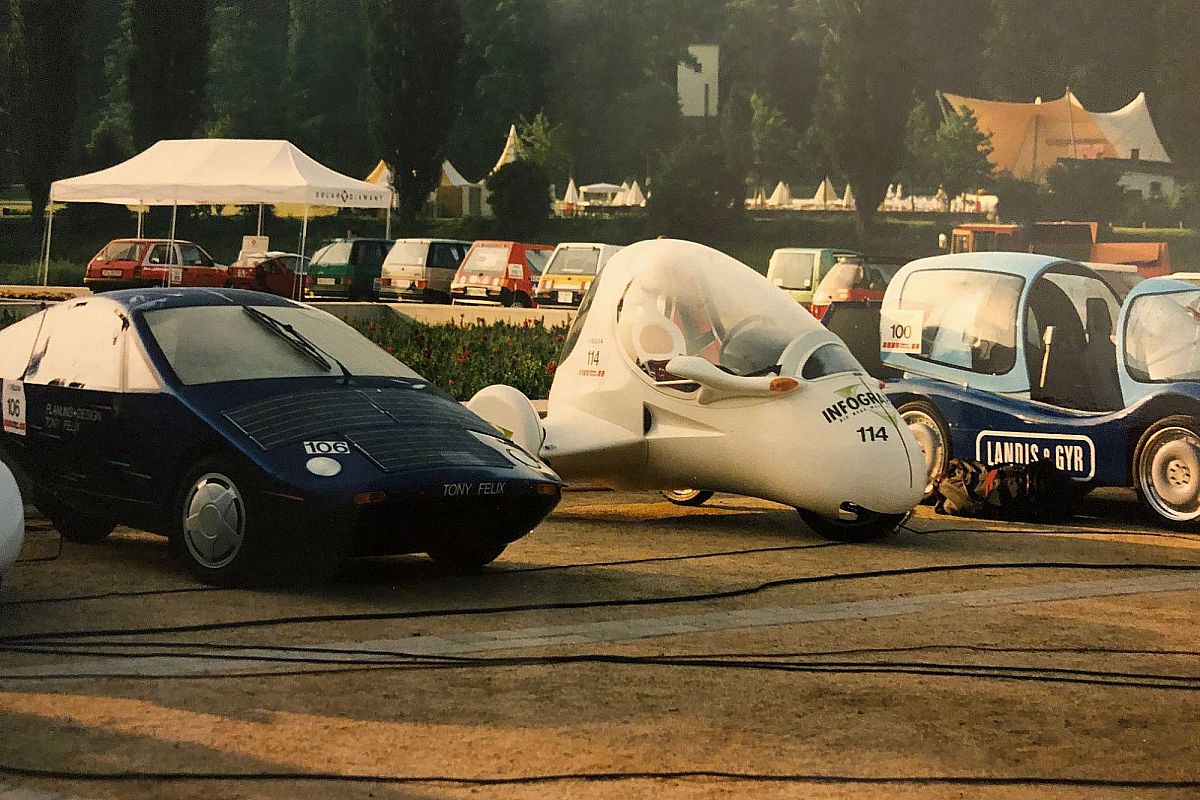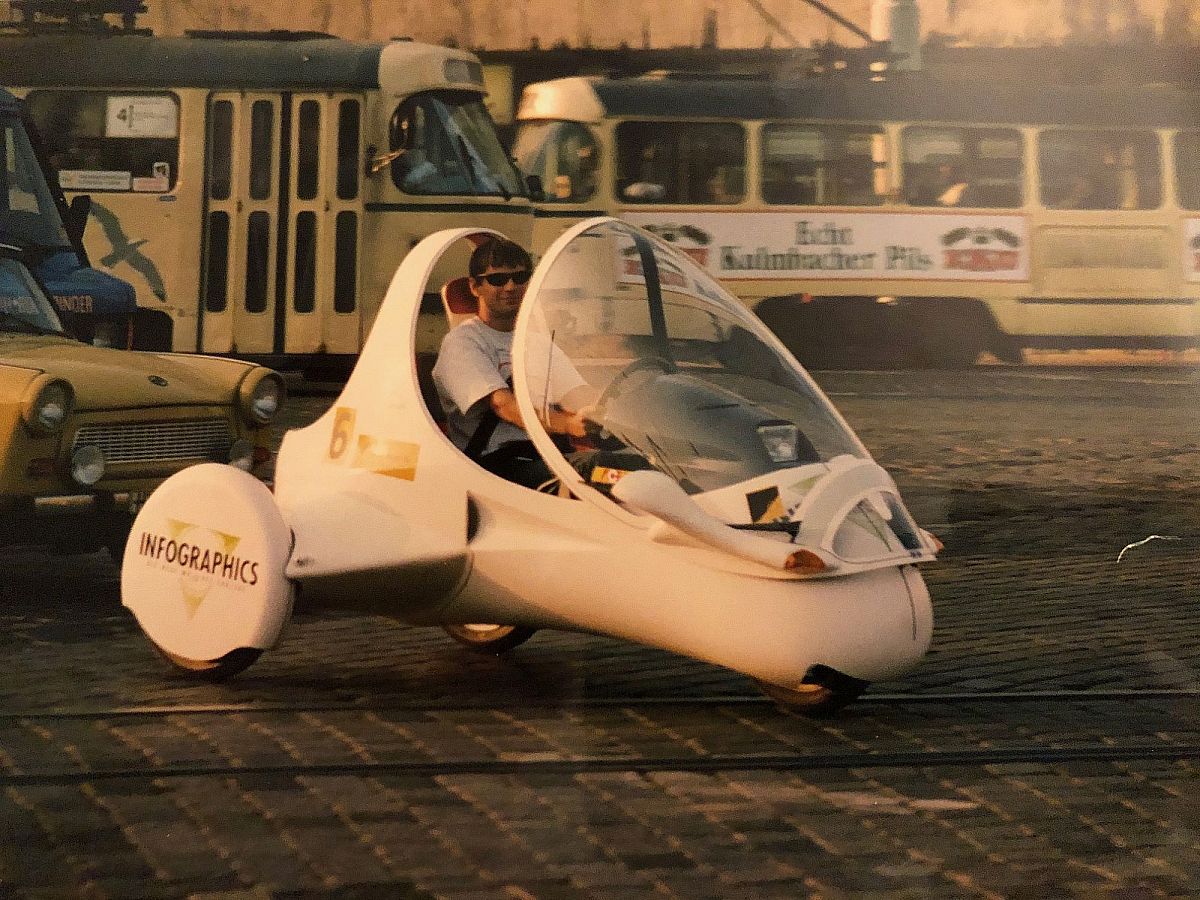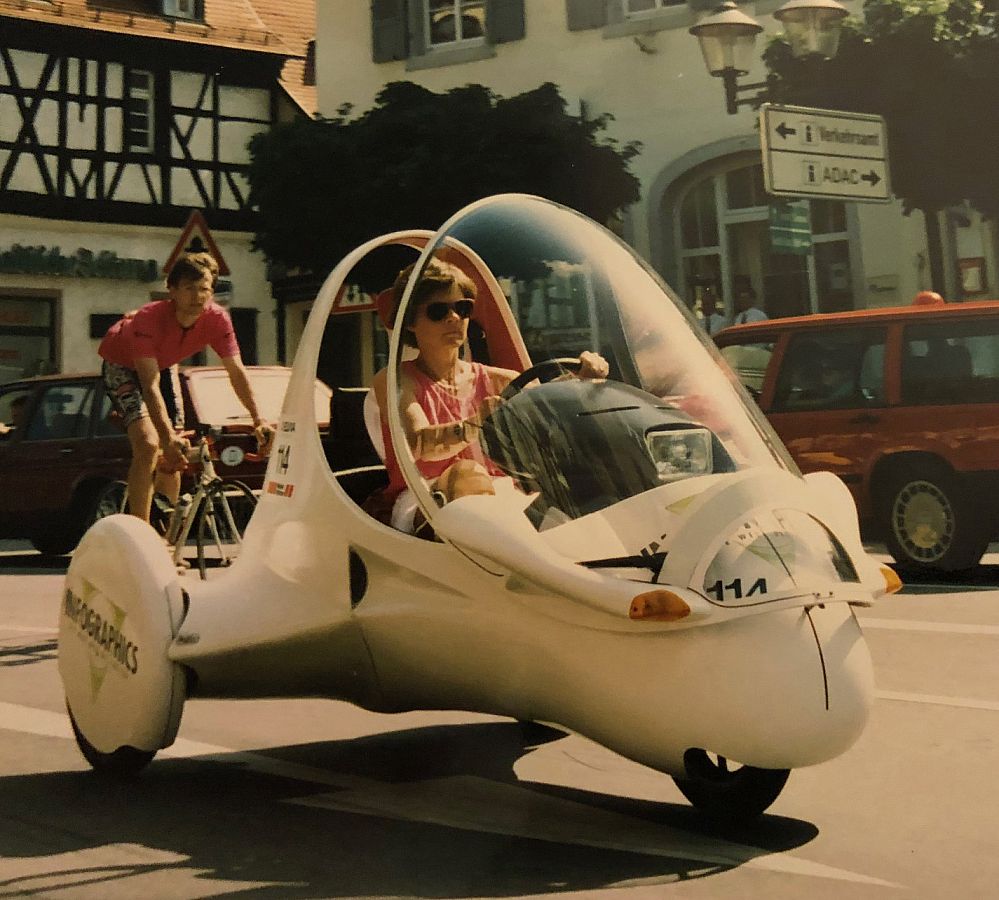Tour de Sol 1992

Start at the Tour de Sol 92
There was not much time left. On Friday I drove another 30 km around the Zürcher Weinland, as carefully as possible, so as not to put too much strain on the newly finished vehicle shortly before the race. Now it was time to pack up and drive Cheetah with the trailer to the start of the race on Saturday morning. The start was in Pforzheim. Christian Ent was our driver. His off-road vehicle was our team vehicle for the next few days and the rented trailer was used to transport Cheetah. After we had just achieved road homologation with Cheetah, the technical inspection of the Tour de Sol was easily passed and we were ready for racing. We had entered my then wife Tina Kyburz as the driver in advance. I was of the opinion that Cheetah would be well tested at the start, Christian Ent would be the driver of the transport vehicle and Gerd and I could think about the race strategy.
As it was to turn out in the course of the race, this was not the optimal division and Cheetah was still completely immature, as we were to learn bitterly.
At that time, the Tour de Sol consisted of various transfer stages from one place to the next. During these transfer stages, as little energy as possible was allowed to be consumed. Otherwise, the only goal was to arrive at the next stage within a generously given time window. At each destination, various special tasks had to be solved.
The first special stage was an acceleration test. Start, full throttle (respectively full power) and the time until reaching the finish flag was measured. Tina excelled and on the first day our team found itself in first place. Everything went perfectly. The transfer stage was coming up. Cheetah was also top in terms of energy consumption. The consumption was under 3kWh/100 km, which was an outstanding value. We felt great and my wife waved to the amazed audience. Until that moment when Tina called me from the moving Cheetah that there had been a loud bang in the drive section at the start of the second transfer stage. Cheetah was still running, but had lost power and when accelerating she had to counter-steer the vehicle with the steering. We wondered and examined Cheetah at the stage finish: full of horror we noticed that one of the two engine drive shafts was broken. A material defect in the engine shaft or a design fault? Later it would turn out that we had constructed a part of the suspension too weak and the load on the engine shaft was therefore too high.

The Tour de Sol participants, one big family. People help each other.
My problem was: I had to find a new engine as quickly as possible. But from whom? I asked around the organisers and the participants until I came across Max Horlacher. Some of the cars he had built were equipped with the same engine. Horlacher was a resounding name back then. He had already built many cars. Several of his vehicles took part in the race with very good drivers: There was Axel Krause with the Horlacher Carbon, Paul Schweizer with his red runabout, Ernst Reinhard with a silver, bigger 4-wheeler and some of his famous Horlacher eggs, one of them driven by Margrit Schweizer. So I was standing in front of the famous Max Horlacher. At that time we were still ahead of all his Horlacher cars on the ranking list with our Cheetah. So I asked him if he happened to have a spare engine. Max was full of praise for the fantastic styling of my vehicle and the driver Tina. According to him, they were both worthy of being raised on a pedestal like a statue.
I explained to Max my problem of the broken engine shaft and that Cheetah would probably only be seen on a podium in a short time, but would not be able to race if I was unable to find an engine. It would have been easy for Max Horlacher to deny me the engine and thus, from his point of view, eliminate a competitor.
Max only said: No, he could not allow that under any circumstances. He had a spare engine at home in his workshop, which he would gladly make available to me. Cheetah had to stay in the race.
My parents agreed to pick up the engine in Möhlin and bring it to the race. Meanwhile, Gerd and I disassembled Cheetah. Unfortunately, the vehicle was built very compactly. No matter which component had to be changed, a complete disassembly and reassembly took about 4 working hours. With Cheetah, all the components were similar to a three-dimensional Tetris game. I learned from this and my later vehicles should be built much more maintenance-friendly.
So on that first race day, one of the two drive motors had to be changed. We were left with little sleep.
On the second day, the race continued. Due to the lack of preparation, we had too little time to prepare the stage. This led to a wrong driving instruction to my wife. Her driving mistake affected the rating and we found ourselves in second intermediate place. Everything was still open.
The next day, the next mistake: something was not connected correctly in our built-in charger. The charging fuse blew. Unsure whether we had really done the wiring properly during the preparation, we set to work: another repair that took several hours. On the third day of racing, it was all about energy consumption. This was another one of Cheetah's prime disciplines. Thanks to its efficiency and its large battery capacity for the time, Cheetah's range was over 150 km. We deliberately did without the charging option at the lunch stop and calculated how we would regain the top spot.
On the afternoon stage, Gerd and I were just fine-tuning our energy strategy and forecasting how many extra laps we could do in the evening when, to our great horror, Tina slowed down more and more in front of us with the Cheetah and finally stopped at the side of the road. Cheetah's batteries were flat. We had obviously not been careful enough when repairing the charger the day before. Cheetah's battery pack consisted of 28 parallel strands. We had simply forgotten to plug in half of the strings, leaving one half of the batteries uncharged and their energy now unavailable. Excited and frantic, we prepared ourselves: What should we do? We had to act if we wanted to keep our chances of a front rank. We were not in agreement: Should we dare to simply plug in the unplugged strands to at least finish the stage? Was there still enough energy in the unplugged battery strings? While we were entangled in the increasingly hectic discussion, one of our team dared to experiment. He plugged in the strings and with a big bang the on-board electronics went bye-bye. This was too much for our team: the argument escalated and in a rage Gerd took his leave and Christian Ent also had to go back to his regular work.
Tina, I and the defective Cheetah were left behind. My parents, who had brought me the engine for the change the day before, were nearby and came by with our PW. They were our escort team for the rest of the race. So we had no choice but to load up Cheetah and transport it to the day's destination. For this day we had collected a "zero". Cheetah and the existing rest team were thrown back. This meant that the chance for one of the front places was gone.
The next repair was due. The charger was broken and had to be replaced by an external unit. The battery had to be rebalanced and carefully charged. The next morning, Cheetah and driver were ready again, although no longer in the top 10 places.
Circuit racing and slalom were on the agenda.
I wondered how all the temperature measuring sensors in my battery showed almost the same temperature and even more that the temperature of the battery after the load test was higher than expected. Where did this come from? Cheetah's energy consumption was increasing and something was no longer right! We drove on. The next day it started to rain and the on-board electronics went crazy. That was the time for me to change places in Cheetah with Tina. I tried to continue the journey without the instruments anyway. The next repair was due and the unauthorised driver change led to more penalty points. In the end, we were bumped down to second last place. Only the German "Schorsch" in his e-Trabbi, who lived in a mill in the forest and generated the energy for the journey in his own hydroelectric power station, was able to leave us behind. Schorsch had done the race with his partner and his huge dog. For him it was more important to be there than to really fight for one of the ranks. For me in the meantime, too. Our race team had disbanded and Cheetah simply still had far too many teething problems: the vehicle was untested. The last stage led to Saas Fee in pouring rain. Shortly before the finish line, Cheetah finally stopped and second last place was the definitive first race result.
Lesson learned:
- When designing a racing vehicle, maintenance and repair must also be taken into account.
- It is not worthwhile to try to compete in a race with a completely untested vehicle.
Acting in a hectic situation leads to consequential mistakes
- I can always rely on my own family.

